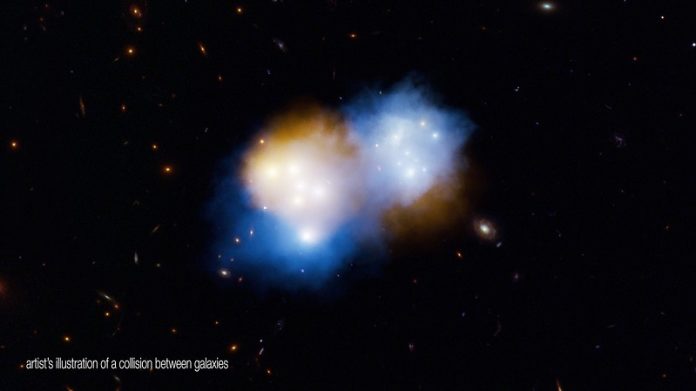
Scientists have observed an incredible cosmic event where dark matter and normal matter separate during a massive collision between two galaxy clusters.
This event, located billions of light-years away, provides a rare glimpse into how dark matter behaves differently from normal matter.
In this collision, two gigantic galaxy clusters, each containing thousands of galaxies, smashed into each other.
Galaxy clusters are some of the largest structures in the universe, held together by gravity.
Surprisingly, only 15% of the mass in these clusters is normal matter (like planets and stars). The remaining 85% is dark matter, an invisible substance that interacts through gravity but doesn’t emit light.
As the clusters collided, the dark matter moved ahead of the normal matter. Normal matter, mostly hot gas, collided and slowed down due to electromagnetic interactions.
However, dark matter, unaffected by these forces, continued moving swiftly. This separation was first observed in a galaxy cluster named MACS J0018.5+1626.
The collision was compared to dump trucks carrying sand crashing into each other.
The sand, like dark matter, flies ahead, while the trucks (normal matter) slow down due to friction and resistance. This analogy helps explain why dark matter and normal matter separated during the collision.
Researchers used various telescopes and observatories to study this event. These included the Caltech Submillimeter Observatory, the W.M. Keck Observatory, NASA’s Chandra X-ray Observatory, and the Hubble Space Telescope, among others.
Some of the data was collected decades ago, but a comprehensive analysis took place in recent years.
A key method used to measure the speed of the gas in the clusters was the kinetic Sunyaev-Zel’dovich (SZ) effect. This effect occurs when photons from the cosmic microwave background scatter off hot gas electrons, causing a Doppler shift. By measuring this shift, scientists can determine the speed of the gas within the galaxy clusters.
The researchers found that the normal matter in MACS J0018.5 was moving in the opposite direction to the dark matter, a puzzling observation at first.
However, further analysis and simulations revealed that the unique orientation of the collision explained this phenomenon. One cluster was moving almost directly toward Earth, while the other was moving away, providing a unique view of the collision dynamics.
The study, led by graduate student Emily Silich and research professor Jack Sayers at Caltech, involved mapping the dark matter using gravitational lensing and simulating the collision. They discovered that the clusters were moving toward each other at about 3,000 kilometers per second, or roughly 1% of the speed of light, before colliding.
This research opens new doors to understanding dark matter. By studying these collisions, scientists hope to learn more about the mysterious properties of dark matter. The findings from this study are just the beginning, with researchers excited about future discoveries.
This groundbreaking study was published in The Astrophysical Journal and funded by various organizations, including the National Science Foundation and the Ministry of Science & Technology in Israel.
Researchers believe this new method of studying dark matter will lead to more insights and a deeper understanding of the universe.
Source: Caltech.



